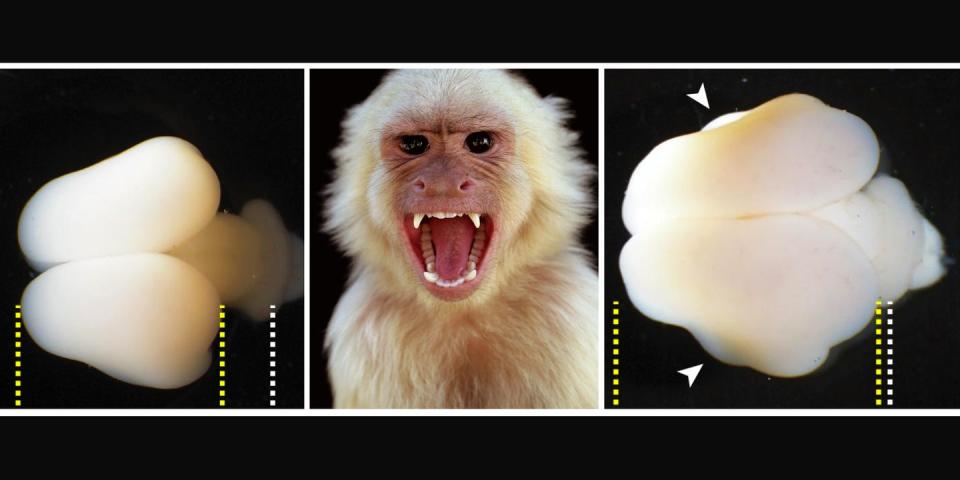Uh-Oh, Scientists Used Human Genes to Make Monkey Brains Bigger, and It Worked

Scientists introduced a human gene, ARHGAP11B, into monkey fetuses.
The gene caused an increase in the size of the monkey brains, including folding similar to that of human brains.
The study poses some serious ethical questions on genetic engineering.
In an experiment that could portend a real-life Planet of the Apes situation, scientists spliced human genes into the fetus of a monkey to substantially increase the size of the primate’s brain. And it worked.
Dive deeper. ➡ Get unlimited access to the weird world of Pop Mech.
Researchers from Germany’s Max Planck Institute of Molecular Cell Biology and Genetics in Germany and Japan’s Central Institute for Experimental Animals introduced a specifically human gene, ARHGAP11B, into the fetus of a common marmoset monkey, causing the enlargement of its brain’s neocortex. The scientists reported their findings in Science.
The neocortex is the newest part of the brain to evolve. It’s in the name—“neo” meaning new, and “cortex” meaning, well, the bark of a tree. This outer shell makes up more than 75 percent of the human brain and is responsible for many of the perks and quirks that make us uniquely human, including reasoning and complex language.
Not long after our hominid ancestors branched off the evolutionary tree of our current chimpanzee cousins, their brains underwent a rapid expansion, nearly tripling in size over a span of 3 million years. Hominids’ brains grew so fast that they became cramped in the slowly evolving craniums, causing the distinctly human folding of the neocortex into wrinkles.
Scientists believe this was the result of a number of evolutionary factors, but the expression of ARGHAP11B, something unique to hominids, may have given a boost to the brains of our ancestors, and close-but-now-extinct relatives, the Neanderthals and Denisovans.

Previous studies have shown that ARHGAP11B, when unnaturally expressed in mice and ferrets, also caused an enlargement of the neocortex. However, this was the first time the gene was used in a non-human primate and with typical human levels of expression, further suggesting the gene played a key role in our evolution.
🐒 Further Reading: A History of Evolution
ARGHAP11B arose in our ancestors some 5 million years ago when a happy little accident was made copying the everyday gene ARGHAP11A. In an evolutionary mistake, a single substitution of one nucleotide base (the molecules that encode DNA) with another led to the loss of 55 nucleotides from ARHGAP11B. Like a computer reading an incorrect line of code, the mutation caused the neuron-producing cells of the brain to make more of themselves for longer periods of time, resulting in a larger neocortex.

“We found indeed that the neocortex of the common marmoset brain was enlarged and the brain surface folded,” Michael Heide, the lead author of the study, said in a press release. “Its cortical plate was also thicker than normal.” He continued:
“Furthermore, we could see increased numbers of basal radial glia progenitors in the outer subventricular zone and increased numbers of upper-layer neurons, the neuron type that increases in primate evolution.”
The scientists call these human-monkey hybrids “transgenic non-human primates,” which may be enough to ring the alarm of any doomsdayer. It certainly raises a lot of ethical questions when doing experiments on primates, let alone when introducing human genes into other animals.
For this reason, the researchers limited their study to monkey fetuses, which were taken out by C-section after growing for 100 days. Allowing the experiment to go past the fetal phase and let the human gene-carrying monkeys to be born would be irresponsible and unethical, study coauthor Wieland Huttner said in the press release.
"We confined our analyses to marmoset fetuses, because we anticipated that the expression of this human-specific gene would affect the neocortex development in the marmoset,” Huttner said. “In light of potential unforeseeable consequences with regard to postnatal brain function, we considered it a prerequisite—and mandatory from an ethical point of view—to first determine the effects of ARHGAP11B on the development of fetal marmoset neocortex."
Watch This:
You Might Also Like
